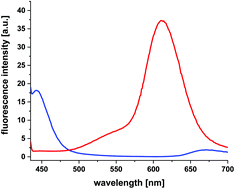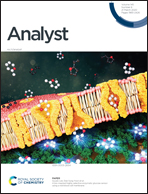Fibre optic ratiometric fluorescence pH sensor for monitoring corrosion in concrete†
Abstract
In this communication a novel concept for pH sensing is introduced which is specifically adapted to monitor carbonation induced corrosion in concrete structures. The method is based on a ratiometric measurement principle, exploiting the pH sensitive colour switching of thymol blue in the basic pH regime and the emissive properties of two different (Zn)CdSe/ZnS core shell quantum dots. The transition point of thymol blue in a Hydrogel D4 matrix was determined to be at around pH 11.6, which fits ideally to the intended application. Next to the fundamental spectroscopic characterization of the ratiometric response, a new design for a sensor head, suitable for the incorporation into concrete matrices is presented. Toward this, a manufacturing process was developed which includes the preparation of a double layer of polymers containing either thymol blue or a quantum dot mixture inside a porous ceramic tube. Results of a proof-of-priciple performance test of the sensor head in solutions of different pH and in cement specimens are presented, with encouraging results paving the way for future field tests in concrete.



 Please wait while we load your content...
Please wait while we load your content...